Soaking up the sun can feel invigorating, but understanding its effects is crucial for healthy skin. Here’s a breakdown of 10 sun protection facts to empower you to make informed choices
Beyond the Burn: Sunburn is just the tip of the iceberg. UV rays penetrate deep, damaging skin cells and significantly increasing the risk of skin cancer. While a tan may seem like a healthy glow, it’s actually a sign of cellular damage.
Broaden Your Spectrum: When choosing sunscreen, “broad spectrum” is your mantra. This shield protects against both UVA rays (responsible for premature aging and wrinkling) and UVB rays (the culprits behind sunburn). Don’t be fooled by labels that only mention UVB protection – you need a comprehensive defense.
Understanding SPF: Sun Protection Factor (SPF) indicates a sunscreen’s ability to block UVB rays. While higher SPF numbers (30+) offer greater protection, it’s essential to remember that SPF is not a magic shield. Reapplication every two hours is crucial, regardless of the SPF, especially if you’re sweating or swimming.
Mineral or Chemical? Know Your Options: Sunscreens come in two main types: mineral and chemical. Mineral sunscreens, also known as physical blockers, sit on the skin’s surface, reflecting UV rays. Chemical sunscreens absorb UV rays and convert them into heat, which is then released from the skin. Both can be effective, so choose based on your preference and skin type. Mineral options are often gentler for sensitive skin, while chemical sunscreens may offer a lighter, more cosmetically elegant feel.
Don’t Be Fooled by Clouds: Up to 80% of UV rays can sneak through clouds, making sun protection essential even on overcast days. Don’t let the cooler temperatures or lack of sunshine lull you into a false sense of security. Pack your sunscreen and apply it liberally before heading outdoors, regardless of the forecast.
Reflection Matters: Be mindful of reflective surfaces like snow, sand, and water. These environments can intensify UV exposure. When enjoying a day at the beach or playing in the snow, be extra vigilant about reapplying sunscreen and consider protective clothing.
Expiry Matters: Sunscreens, like any other product, have a shelf life. Their effectiveness diminishes over time. Make a habit of checking the expiration date on your sunscreen and replacing expired products to ensure optimal protection. Using sunscreen that’s past its prime is like putting on a rusty suit of armor; it simply won’t offer the defense you need.
Water Resistance is Not Waterproof: Don’t be misled by labels claiming “waterproof” sunscreens. Swimming, sweating, or simply toweling dry can remove sunscreen. To maintain protection, reapply sunscreen frequently, especially after water activities.
Sun Protection for All: Regardless of skin tone or melanin levels, everyone needs sun protection. While melanin offers some natural defense, sun damage can occur on all skin types. Find a sunscreen that suits your needs and make sun safety a priority.
Dress for Success: Sun-protective clothing with a UPF (Ultraviolet Protection Factor) rating provides an additional layer of defense. Opt for long-sleeved shirts, pants, and wide-brimmed hats whenever possible. Sunglasses that block UVA and UVB rays are also essential for safeguarding your eyes from sun damage.
